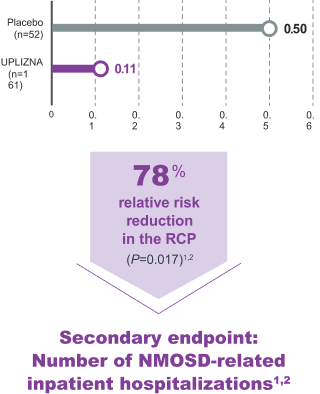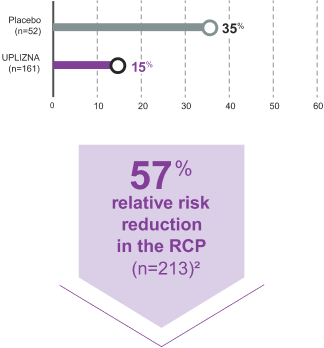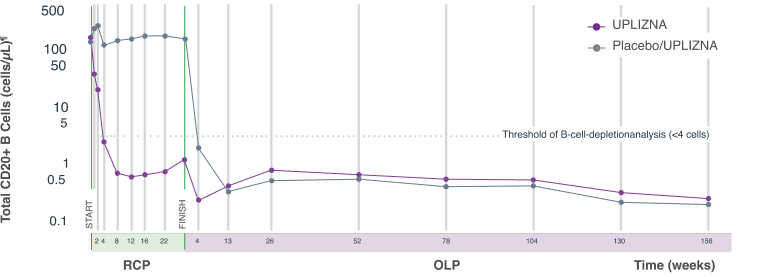IMPORTANT SAFETY INFORMATION AND INDICATIONS
CONTRAINDICATIONS
UPLIZNA® (inebilizumab-cdon) is contraindicated in patients with a history of a life-threatening infusion reaction to UPLIZNA, active hepatitis B infection, or active or untreated latent tuberculosis.
WARNINGS AND PRECAUTIONS
- Infusion Reactions: Can cause infusion reactions, including anaphylaxis. Symptoms can include headache, nausea, somnolence, dyspnea, fever, myalgia, rash, or palpitations. During the randomized clinical trial period (RCP), infusion reactions were observed with the first course of UPLIZNA in 9.3% of NMOSD patients. Infusion reactions of UPLIZNA were observed in 7.4% of IgG4-RD patients during the RCP. Infusion reactions were most common with the first infusion but were also observed during subsequent infusions.
Administer pre-medication with a corticosteroid, an antihistamine, and an antipyretic. For life-threatening infusion reactions, immediately and permanently stop UPLIZNA and administer appropriate supportive treatment. For less severe infusion reactions, management may involve temporarily stopping the infusion, reducing the infusion rate, and/or administering symptomatic treatment. - Infections: An increased risk of infections has been observed with other B-cell depleting therapies. The most common infections reported by UPLIZNA-treated patients in the NMOSD RCP and open-label clinical trial periods were urinary tract infection (20%), nasopharyngitis (13%), upper respiratory tract infection (8%), and influenza (7%). In the IgG4-RD RCP and open-label period, the most common infections reported by UPLIZNA-treated patients were upper respiratory tract infection (11%), nasopharyngitis (10%), urinary tract infection (9%), and influenza (6%). Delay UPLIZNA administration in patients with an active infection until the infection is resolved.
Possible Increased Risk of Immunosuppressant Effects with Other Immunosuppressants: UPLIZNA has not been studied in combination with other immunosuppressants. If combining UPLIZNA with another immunosuppressive therapy, consider the potential for increased immunosuppressive effects.
Hepatitis B Virus (HBV) Reactivation: Risk of HBV reactivation has been observed with other B-cell depleting antibodies. There have been no cases of HBV reactivation in patients treated with UPLIZNA, but patients with chronic HBV infection were excluded from clinical trials. Perform HBV screening in all patients before initiation of treatment. Do not administer to patients with active hepatitis. For patients who are chronic carriers of HBV [HBsAg+], consult liver disease experts before starting and during treatment.
Progressive Multifocal Leukoencephalopathy (PML): Although no confirmed cases of PML were identified in UPLIZNA clinical trials, JC virus infection resulting in PML has been observed in patients treated with other B-cell depleting antibodies and other therapies that affect immune competence. In UPLIZNA clinical trials one subject died following the development of new brain lesions for which a definitive diagnosis could not be established, though the differential diagnosis included an atypical NMOSD relapse, PML, or acute disseminated encephalomyelitis. At the first sign or symptom suggestive of PML, withhold UPLIZNA and perform an appropriate diagnostic evaluation. MRI findings may be apparent before clinical signs or symptoms. Typical symptoms associated with PML are diverse, progress over days to weeks, and include progressive weakness on one side of the body or clumsiness of limbs, disturbance of vision, and changes in thinking, memory, and orientation leading to confusion and personality changes.
Tuberculosis
Patients should be evaluated for tuberculosis risk factors and tested for latent infection prior to initiating UPLIZNA. Consider anti-tuberculosis therapy prior to initiation of UPLIZNA in patients with a history of latent active tuberculosis in whom an adequate course of treatment cannot be confirmed, and for patients with a negative test for latent tuberculosis but having risk factors for tuberculosis infection. Consult infectious disease experts regarding whether initiating anti-tuberculosis therapy is appropriate before starting treatment.
Vaccinations
Administer all immunizations according to immunization guidelines at least 4 weeks prior to initiation of UPLIZNA. The safety of immunization with live or live-attenuated vaccines following UPLIZNA therapy has not been studied, and vaccination with live-attenuated or live vaccines is not recommended during treatment and until B-cell repletion.
Vaccination of Infants Born to Mothers Treated with UPLIZNA During Pregnancy
In infants of mothers exposed to UPLIZNA during pregnancy, do not administer live or live-attenuated vaccines before confirming recovery of B-cell counts in the infant. Depletion of B-cells in these exposed infants may increase the risks from live or live-attenuated vaccines. Non-live vaccines, as indicated, may be administered prior to recovery from B-cell and immunoglobulin level depletion, but consultation with a qualified specialist should be considered to assess whether a protective immune response was mounted. - Reductions in Immunoglobulins: There may be a progressive and prolonged hypogammaglobulinemia or decline in the levels of total and individual immunoglobulins such as immunoglobulins G and M (IgG and IgM) with continued UPLIZNA treatment. Monitor the levels of quantitative serum immunoglobulins during treatment with UPLIZNA, especially in patients with opportunistic or recurrent infections, and until B-cell repletion after discontinuation of therapy. Consider discontinuing UPLIZNA therapy if a patient with low immunoglobulin G or M develops a serious opportunistic infection or recurrent infections, or if prolonged hypogammaglobulinemia requires treatment with intravenous immunoglobulins.
- Fetal Risk: Based on animal data, UPLIZNA can cause fetal harm due to B-cell lymphopenia and reduce antibody response in offspring exposed to UPLIZNA even after B-cell repletion. Transient peripheral B-cell depletion and lymphocytopenia have been reported in infants born to mothers exposed to other B-cell depleting antibodies during pregnancy. Advise females of reproductive potential to use effective contraception while receiving UPLIZNA and for at least 6 months after the last dose.
ADVERSE REACTIONS
- The most common adverse reactions in NMOSD (at least 10% of patients treated with UPLIZNA and greater than placebo) were urinary tract infection and arthralgia.
- The most common adverse reactions in IgG4-RD (at least 10% of patients treated with UPLIZNA and greater than placebo) were urinary tract infections and lymphopenia.
INDICATIONS
UPLIZNA® (inebilizumab-cdon) is indicated for the treatment of neuromyelitis optica spectrum disorder (NMOSD) in adult patients who are anti-aquaporin-4 (AQP4) antibody positive.
UPLIZNA® is indicated for the treatment of Immunoglobulin G4-related disease (IgG4-RD) in adult patients.
Please see UPLIZNA Full Prescribing Information.







